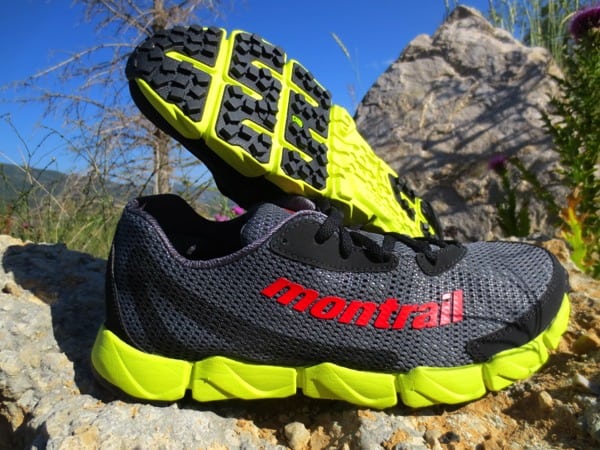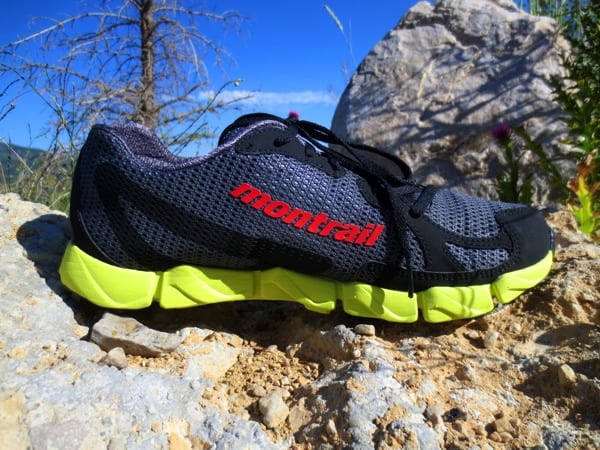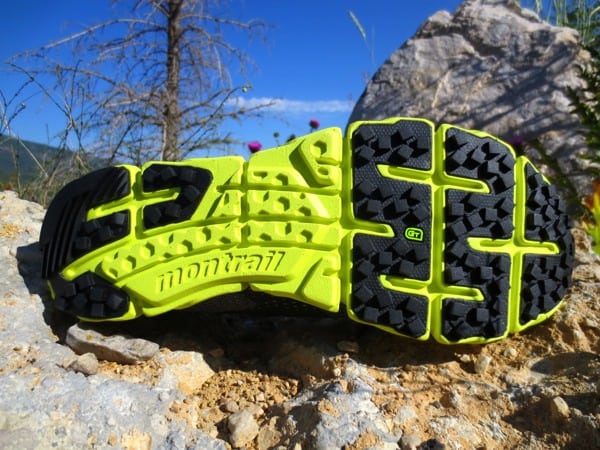Our Favorite Trail Running Shoes
Check out our Best Trail Running Shoes article to learn about our current favorite trail running shoes!
Montrail FluidFlex Review
Occam’s Razor, a principle used in logic and problem solving, states that the simplest explanation is usually correct. Montrail may have been employing this principle when designing the Montrail FluidFlex ($90) trail/road hybrid running shoe. If you have a material that is simple yet effective, in this case Montrail’s FluidFoam, why muck it up by overbuilding a shoe around it? In response to this question, Montrail designed an elegantly simple hybrid shoe, without any superfluous materials, which highlights the fantastically bouncy and resilient FluidFoam technology.

The Montrail FluidFlex
Upper
The FluidFlex defines breathability with an open Airmesh upper throughout the full length of the shoe. The Airmesh is reinforced by a durable nylon lining on both sides of the midfoot inside the shoe, and sewn overlays are present only around the toecap. This gives the upper a great deal of flexibility and can give the shoe a sloppy feel to first-time wearers despite the shoe being true to size. Several runs in I found that the upper was more than supportive enough to keep my foot firmly on top of the cushy midsole. Runners looking for a shoe to wear in wet conditions will appreciate the drainage capabilities of the FluidFlex due to the almost entirely mesh upper. My feet were dry within 10 minutes after crossing creeks and even when running in the rain, the shoe does not absorb water or become squishy.

The Montrail FluidFlex’s lateral upper.
Asymmetrical lacing provides additional support through the midfoot, and Montrail reinforced the eyelets to add durability. I found that I could lace up the FluidFlex very tight or very loose depending on the type of trail conditions and workout I was running that day. A flexible and minimal heel cup is given extra comfort by the placement of two soft pads on either side of the ankle that I expect did their job as I never experienced any rubbing or discomfort in the heel. The FluidFlex does have a pronounced heel cup which cradles the heel up to the achilles tendon snugly. This design took awhile to get used to, but improves the lockdown of the shoe, especially while running uphill. Again, after several runs I only noticed this when I first slipped the shoe on before running, and I haven’t experienced any discomfort.
The toe box of the FluidFlex is wide enough, but undermined by a bit of a tapered shape which took my feet some time to get used to. Barely noticeable, this taper may place some pressure on runner’s pinky toes, and while I didn’t have any problems I would hope that this design feature is improved in future editions.

The Montrail FluidFlex’s medial upper.
Midsole/Outsole
Segmented FluidFoam runs the entire length of the shoe with a 4mm heel drop. The segmentation increases the flexibility of the already malleable FluidFoam, but is nowhere near as deep as something like a Nike Free. There is almost no torsional rigidity in this shoe (twists very easily) and the FluidFlex really has the feel of a racing flat.
I’m going to do my best to explain the feel of FluidFoam, but remember that this is my subjective opinion. FluidFoam is a very soft, very bouncy, EVA foam whose closest comparison on the market is Nike Lunarlon foam, which is present in Nike’s Lunar shoe series. However, FluidFoam seems to be even lighter, and it is absolutely impressive how much foam Montrail is able to put underfoot while keeping the weight of the FluidFlex at 7.6 oounces (men’s size 9). FluidFoam is also one of the softest foams on the market, which had me worried that it would compress and loose its bounciness. Well, I can resoundingly say that after 400 miles the FluidFoam still feels great and this minimal shoe has held up incredibly well.
It is important to point out that there is no rock plate present in the FluidFlex. Maybe this was done to keep the shoe as flexible as possible, and for the most part a rock plate is not needed due to the substantial cushioning of the FluidFoam. There have only been a few occasions where I felt discomfort from a rock through the FluidFoam and for the most part this design works fine. Also missing (or welcomed depending on the runner) is noticeable arch support. The inside of the FluidFlex is not contoured which means that your feet do more of the work.
Montrail’s Gryptonite outsole pattern is placed on the forefoot and the heel of the shoe leaving the FluidFoam exposed at midfoot. Initially, I thought that I would wear the exposed foam down as a midfoot striker, but it seems to be holding up. The Gryptonite on the forefoot is very tacky and works great when ascending and rock hopping. Additionally, some foreward facing grooves on the heel provide a bit of breaking during descents.

The Montrail FluidFlex’s outsole.
Overall Impression
I have been wearing the FluidFlex for several months now and, initially, I focused on the low weight and wearing the shoe for speed workouts and hill repeats. In the last several months I’ve extended this shoe up to five hours running on mountain trails and it continues to impress me. One of my favorite aspects of the FluidFlex is that I can wear it on the road with the same degree of comfort as my road shoes, and this is the best hybrid shoe on the market in my opinion. For the runner looking for a lightweight shoe to run trails, roads, races, and long runs in, this is your shoe.
Whether the FluidFlex could be a great shoe for races over 50 miles is in the eye of the beholder. Personally, I enjoy wearing the FluidFlex for faster outings on less technical trails when I want to push the pace. The FluidFoam firms up great at a fast cadence. Certainly there is no shortage of cushioning in the FluidFlex and I never finished a run feeling like my feet were beat up or sore. This shoe is a great choice for runners looking for a minimal feel with maximal cushioning.
